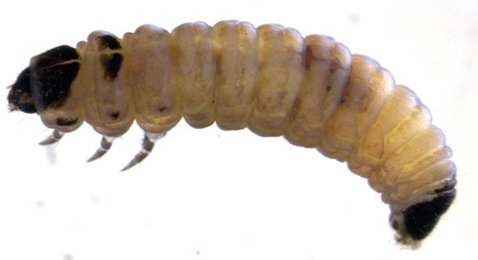|
||||||
|
LYTHRUM. [Lythraceae] |
|
Two species of Lythrum, Angled Purple-loosestrife (L. alatum) and Grass-poly (L. hyssopifolia), are recorded in Britain. Two British miners are recorded on Lythrum. A key to the European miners recorded on Lythrum is provided in Bladmineerders van Europa. |
|
Key for the identification of the known mines of British |
1a > Leaf-miner: Initially a gallery is formed, this turning into a blotch, and later two successive conical leaf-rolls. Initially a pale, later brown, usually lower-surface blotch. The blotch is preceded by an epidermal corridor, but that may be obliterated by the later blotch. Silk at the inside of the mine causes it to buckle up a bit and fold. The reddish brown frass is accumulated in a corner of the mine. The older larva leaves the mine and continues feeding inside an untidy cone, made by cutting off a strip of leaf tissue and stitching it in place with silk. |
|
Calybites phasianipennella (Hübner, 1813) [Lepidoptera: Gracillariidae]. |
1b > Leaf-miner and case-bearer: The larva feeds on a wide range of trees, shrubs and herbs, favouring Rosaceae, but not exclusively. The fully developed cased larva may be found active in October and again, after winter diapause, in April. Cases, about 6 mm, of diapausing larvae may be found through winter, fixed to a tree or fence post. The dorsal surface of the case is usually covered in leaf fragments, but they can sometimes be worn off almost smooth. The ventral surface is swollen at the middle and has a keel, which usually bends upwards at the posterior. The cases of C. ahenella (on Rhamnus, Frangula, Viburnum and Cornus) and C. potentillae (case less swollen, keel not bent up, resting position less prone) are very similar. Brownish lobe case that lies almost flat on the leaf, either on the upper or on the lower side. Case widest about the middle. Ventrally there is a distinct keel. Mouth angle 0°. Full depth mines rather large. The flaps of cuticular tissue that serve to enlarge the case are cut out of the upper epidermis. (contrary to C. ahenella and C. potentillae, that use tissue from the lower epidermis). The removal of these tissue flaps creates holes that are much larger than those that serve as the entrance to the mine. |
 Coleophora violacea larva, lateral Image: © Willem Ellis (Bladmineerders van Europa) |
|
Coleophora violaceae (Ström 1783) [Lepidoptera: Coleophoridae]. |
| Last updated 05-Jul-2019 Brian Pitkin | ||
